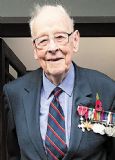Mr Ernest Sandford MBE

MR Ernest Sandford, who died recently at the grand age of 97, was a remarkable man who is sadly missed.
Known as Sandy to his many friends, he was born on August 9, 1923, at Tiverton, Devon. The son of a Church of England rector, he was educated at Marlborough College and was awarded a place to study Classics at Clare College Cambridge. However, with the onset of the war he immediately joined the Royal Marines and commanded a tank landing craft which was built at Harland and Wolff in Belfast.
Thirteen in total set sail from Belfast, bound for the Mediterranean, but trouble set in off the Welsh coast and Sandy made for Milford Haven for engine repairs, only learning later that all the other craft were lost in a storm in Biscay. The holds in these boats were only protected by a canvas cover and no match for mountainous seas.
Sandy later served in the invasion of Italy at Salerno, Messina, Anzio and Taranto. His landing craft was fitted with a six-inch gun and hence he and two other similar craft were ordered to chase down and sink an Italian destroyer, which under the cover of a sea mist, they achieved.
After the invasion he was ordered to India to train for the assault on Japan which never happened due to the atomic bombs.
He contracted dysentery and was repatriated to Kent for recuperation. From his hospital bed he watched golfers playing on the local course and decided he would try it when well enough. Thus, a love was born and he died one of the oldest members of Royal County Down Golf Club.
On another posting to the South Coast he went to a dance and met Patricia Heyn, who was stationed as a WAAF at the radar station at Sennen Cove.
Love blossomed and when the war ended, he went with her back to Craigavad, where Pat’s well-connected parents soon found Sandy a job as a photographer for the News Letter. Sandy told of hair-raising climbs of the cranes at the shipyard to photograph ship launches. The best pictures still earn the money.
In 1948 he was offered the trainee managership of Hurst’s Mill in Drumaness where flax was spun. In 1949 he and Pat married at Glencraig, Holywood, with a reception at The Hill. They settled in Wayside Cottage at the Spa and Sandy was promoted to manager of the mill, later moving to Harmony Hill in Drumaness where their first two children, Jill and David, were born. Sandy played cricket for Drumaness and was keen to promote the game where many of the players were workers in the mill.
In 1959 the opportunity to buy his own farm arose and the family moved to Portloughan, near Castleward, where they had two more children, Julian and Philip.
Sandy was determined not to buy anything that he could make himself and over his lifetime built four boats, the last one a 48 foot long ferro cement ketch. Holidays were undertaken in a caravan which he had, naturally, built from scratch.
When the Ulster Defence Regiment was formed, he immediately joined up and with the rank of Major, commanded ‘A’ Company, 3 UDR at Carryduff. In his words he did so “to give a little back to the country which had given him so much”. He was awarded an MBE for his services.
He was appointed High Sheriff of County Down in 1985 and then Deputy Lieutenant in 1988.
Sadly, in 1984 Pat died, having suffered for many years with MS. He married again, to a long-standing widowed friend of theirs, Mary Clark, from the mill family at Upperlands, and spent many happy years together in new home they had built at Portloughan, travelling the world and enjoying their retirement.
After Mary’s death Sandy spent his last years surrounded by his family. An accomplished farmer, craftsman, father, fisherman, game shot and golfer, he died in August and had a small family funeral at Saul Parish Church where he is interred.

